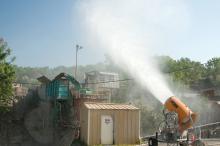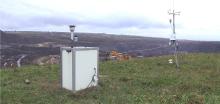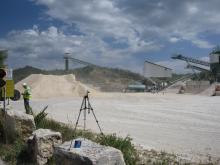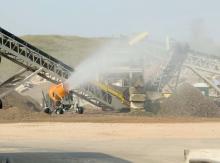
The need to achieve a balance between demand for aggregates and local communities’ desire to be protected from the potential negative impacts of quarrying is one which applies to both new and existing sites. In particular, quarry operators can be faced with significant resistance from local communities and action groups about the amount of dust generated. Rachel McHale, Senior Air Quality, Dust and Odour Consultant, at environmental firm
Dust generated from quarries is best categorised on its size, as this determines the distance it can travel once it has become airborne and whether or not the risk of impact relates to local amenity or health issues. Particles of more than 30 micrometres (μm) in diameter generally deposit within 100m of the source, and can cause impacts upon local amenity in terms of dust deposition and soiling on surfaces. Particles of less than 10 μm and 2.5 μm in diameter (PM10 and PM2.5, respectively) have the potential to remain airborne for longer periods and can therefore travel considerably further from the source. PM10 particles and in particular PM2.5 particles have the potential to impact upon health due to being small enough to enter the respiratory system.
Historically, with the exception of opencast coal mining, the focus of public concern has been the impact upon local amenity from dust deposition and soiling. As a result, it has been commonplace for planning or permitting conditions to include the monitoring of deposited dust. Such conditions are typically agreed using passive monitoring systems such as the Frisbee gauge or adhesive dust strips; both of which are cost-effective and provide absolute values comparable against custom and practice limit values, for assessment of long-term dust deposition.
Although well documented that quarrying is a small contributor to concentrations of PM2.5, the surge in media coverage and resulting public awareness of the potential health impacts means that the public requires increased reassurance that existing or proposed mineral developments will not introduce such risks into their local community.
Guidance available for undertaking impact assessments of PM10 as part of the planning or permitting process is fairly limited at the present time; with the National Planning Policy Framework (NPPF) providing one of the more commonly used methodologies (see Figure 1). The UK’s Institute of Air Quality Management (IAQM) also now has a working group actively developing guidance on the assessment of dust emissions from the mineral industry, due to this current gap and the need for a degree of consistency for impact assessments.
The method within the NPPF takes into account the background concentrations of PM10 for the area of a site, the potential contribution of the quarry and the likelihood of the Air Quality Objective (AQO) being exceeded. Due to the typically rural nature of quarry sites, background concentrations are generally low with risks of an AQO exceedance considered unlikely.
Due to the potential health impacts of these smaller particles, local action groups are putting increasing pressure on the regulators to justify the background concentrations used in the impact assessments and the likely contributions from a development. The background concentrations are commonly predicted using the 1km Defra maps, due to the lack of site specific information or local monitoring stations in proximity to the site.
As a result, baseline monitoring of PM10 can be requested by the planning authority and/or regulator to ensure that the risk of an AQO exceedance is in line with that proposed within the impact assessment - thereby reassuring the public. Such requests tend to be limited to proposals with a high conflict of interest and/or community involvement due to the sensitivity and proximity of receptors or cumulative impacts with other local industries.
The financial implications for the operator of monitoring PM10 and PM2.5 are however dependent upon the level of detail required. Baseline monitoring does not necessarily require continuous readings that can be provided by the more costly instrumentation. More cost-effective techniques are now available allowing for weekly or daily collections of particulate samples for analysis and allow for an indicative comparison against the annual AQO for PM10. For background monitoring where short-term peaks do not need to be recorded, these allow for the compliance with the requirements without large upfront investments or ongoing maintenance costs.
The outcome of any baseline monitoring will determine whether further monitoring is required once the development becomes operational. As an example, Bardon Hill quarry in Coalville, county Leicestershire, England undertook baseline monitoring as part of its impact assessment for a proposed extension. The major influence on PM10 concentrations was found to be from regional and transboundary particles, with existing quarry operations found to contribute only a small percentage of monitored PM10 concentrations.
Should further detail be required it is then that the significant cost implications begin to become apparent. Where the daily fluctuation of concentrations is required or comparison against the 24-hour AQO for PM10, continuous monitoring (typically 1-hour or 15-minute average periods) requires automatic monitors, which in turn have their own limitations, such as the need for power supply and ongoing maintenance.
In the more extreme cases monitoring may be required for the immediate recognition of certain trigger levels in order to action the necessary controls within the site’s Dust Management Plan (DMP). An example of this was proposed within the DMP for a sand and gravel quarry in county Hertfordshire, England due to the risk of impact upon an observatory located within 600m. The DMP proposed for automatic monitors to be located at relevant locations and an alarm sent to the operator as soon as the trigger level was approached. Whether day or night, the site would then action the relevant additional control measures within its DMP.
It is at this point that the importance of a DMP needs to be recognised. Once particles, of any size, are generated and become airborne, there is little or no control over the impact they will have upon the locality. If this is seen as a likely risk then monitoring may be requested to observe the impact upon local concentrations. Prevention in the release of these particles is therefore essential and the effectiveness of an active management document which is continually reviewed and updated is one that both regulators and local communities will also look to for reassurance. If it can be seen that the working methods, control measures and action plans have been considered carefully with particular reference to sensitive receptors in the local area, the local community are likely to have greater confidence that the operators have the welfare of the local community as its top priority.
From the operator’s point of view, the key focus is compliance with any requirements placed upon them in a way that minimises upfront investment and ongoing costs. The production of a high quality and effective DMP as a precedent to any quarry development will assist the regulators in making an informed decision as to whether monitoring is required and the degree of detail needed.












